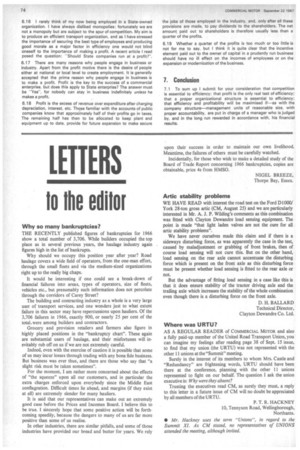LETTERS
Page 76

If you've noticed an error in this article please click here to report it so we can fix it.
to the editor
Why so many bankruptcies?
THE RECENTLY published figures of bankruptcies for 1966 show a total number of 3,706. While builders occupied the top place as in several previous years, the haulage industry again figures high in the list of bankrupts.
Why should we occupy this position year after year? Road haulage covers a wide field of operators, from the one-man effort, through the small fleets and via the medium-sized organizations right up to the really big chaps.
It would be interesting if one could see a break-down of financial failures into areas, types of operators, size of fleets, vehicles etc., but presumably such information does not percolate through the corridors of Carey Street?
The building and contracting industry as a whole is a very large user of transport services, and one wonders just to what extent failure in this sector may have repercussions upon hauliers. Of the 3,706 failures in 1966, exactly 900, or nearly 25 per cent of the total.were among builders and contractors.
Grocery and provision retailers and farmers also figure in highly placed positions in the "bankruptcy chart". These again are substantial users of haulage, and their misfortunes will inevitably rub off on us if we are not extremely careful.
Indeed, even with the exercise of caution it is possible that some of us may incur losses through trading with any bona fide business. But business was ever thus, and there are those who say that "a slight risk must be taken sometimes".
For the moment, I am rather more concerned about the effects of "the squeeze" upon all our customers, and in particular the extra charges enforced upon everybody since the Middle East conflagration. Difficult times lie ahead, and margins (if they exist at all) are extremely slender for many hauliers.
It is said that our representatives can make out an extremely good case before the Prices and Incomes Board. I believe this to be true. I sincerely hope that some positive action will be forthcoming speedily, because the dangers to many of us are far more positive than some of us realise.
In other industries, there are similar pitfalls, and some of those industries have provided our bread and butter for years. We rely
Artic stability problems upon their success in order to maintain our own livelihood. Meantime, the failures of others must be carefully watched.
Incidentally, for those who wish to make a detailed study of the Board of Trade Report concerning 1966 bankruptcies, copies are obtainable, price 4s from HMSO.
NIGEL BREEZE, Thorpe Bay, Essex.
WE HAVE READ with interest the road test on the Ford D1000/ York 28-ton gross artic (CM, August 25) and we are particularly interested in Mr. A. J. P. Wilding's comments as this combination was fitted with Clayton Dewandre load sensing equipment. The point is made "that light laden valves are not the cure for all artic stability problems".
We have never ourselves made this claim and if there is a sideways disturbing force, as was apparently the case in the test, caused by maladjustment or grabbing of front brakes, then of course load sensing will not cure this. But on the other hand, load sensing on the rear axle cannot accentuate the disturbing force which is present on the front axle as this disturbing force must be present whether load sensing is fitted to the rear axle or not.
But the advantage of fitting load sensing in a case like this is that it does ensure stability of the tractor driving axle and the trailing axle which increases the stability of the whole combination even though there is a disturbing force on the front axle.
D. H. BALLARD Technical Director, Clayton Dewandre Co. Ltd.
Where was URTU?
AS A REGULAR READER of COMMERCIAL MOTOR and also a fully paid-up member of the United Road Transport Union, you can imagine my feelings after reading page 38 of Sept. 15 issue, to find that my union (the URTU) was not represented with the other 11 unions at the "Summit" meeting.
Surely in the interest of its members to whom Mrs. Castle and "Redundancy" are frightening words, URTU should have been there at the conference, planning with the other 11 unions represented to fight on our behalf'. The question I ask the union executive is: Why were they absent?
Trusting the executives read CM, as surely they must, a reply to this letter in a future issue of CM will no doubt be appreciated by all members of the URTU.
P. T. R. HACKNEY 10, Tennyson Road, Wellingborough, Northants.
• Mr. Hackney uses the term "Unions", in regard to the Summit XI. As CM stated, no representatives of UNIONS attended the meeting, although invited.




























































































































